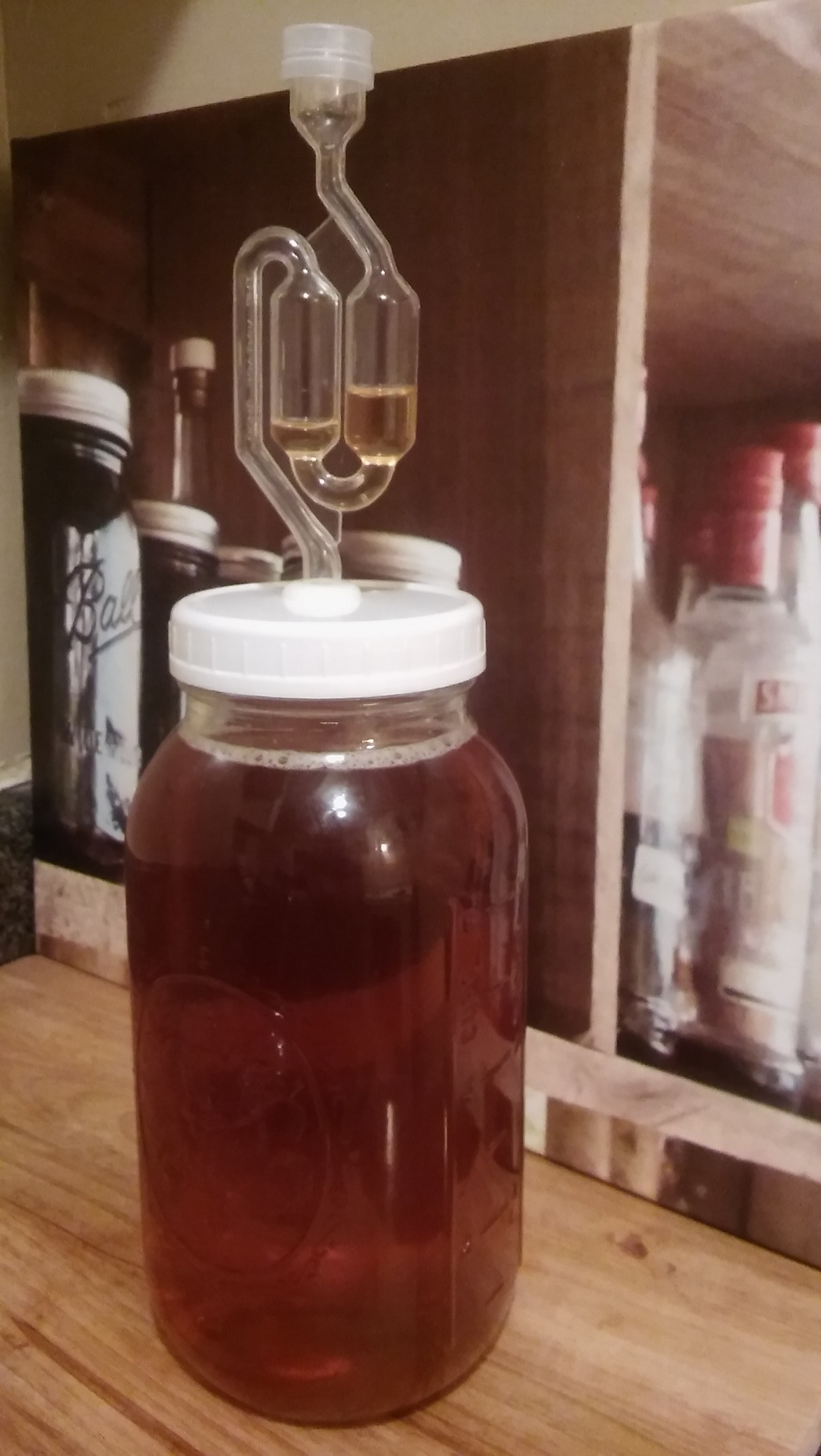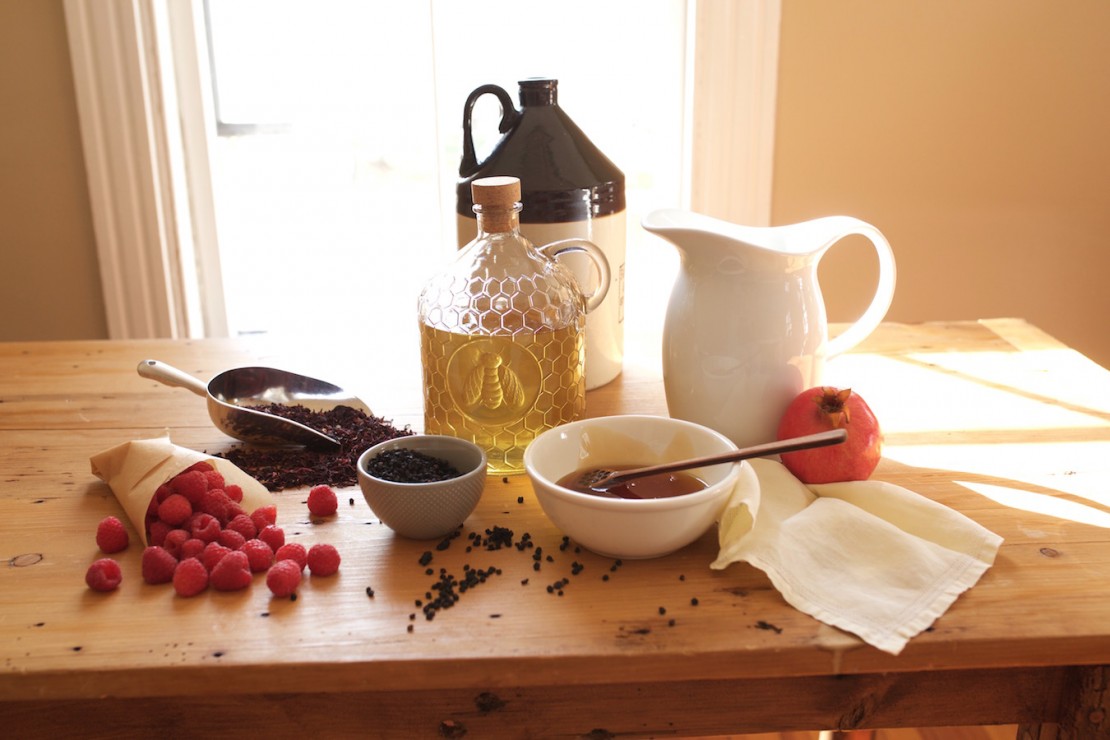
How To Make Herbal Homemade Wine and Mead
With the explosion of the DIY movement in recent years, more people seem to be returning to old-school food and drink traditions, many of them involving fermentation. The HuffPost’s hilarious list of “The 22 Most Hipster Foods On The Planet” includes a great many of these, from kombucha to pickles, craft beers to kimchee. But as we herbalists know, these traditions aren’t new at all, and they’re definitely not just for hipsters. My older relatives (and yours too, I’ll bet) were making herbal homemade wine and mead long before homebrewing was de rigueur, and guess what? You can too!
A Bit of History
Wine and mead have been around for as long as humans have documented history (and a long time before that) according to archeological finds. The ancient Egyptians were the first to document in great detail the technology and technique of winemaking, a process that seems to have been mastered as early as 5000 years ago. But we know that the cultivation of grapes began long before that, with excavations in Syria, Lebanon and Jordan unearthing pips from cultivated grapevines carbon-dated at about 8000 B.C.E. (Johnson, 1999).
Mead, in its most basic form (honey and water fermented with yeast), has an equally long history. Greek tradition holds that it was a drink enjoyed by Zeus and lesser gods, and it played a hugely important role among ancient Druids, with many a chant and hymn composed in its honor (Nash, 1858). In Ethiopia, tej (honey wine) has been produced since antiquity and continues to play a pivotal role in sustaining community ties, particularly in rural areas (Fichtl & Adi, 1994).
Then and now, part of the appeal of these intoxicating beverages is their effect. The ancients discovered quickly that under the influence of ethanol (the alcohol produced by the interaction of yeasts and sugars) their “anxieties disappeared, their fears receded, ideas came more easily, lover became more loving when they drank the magic juice. For a while they felt all-powerful, even felt themselves to be gods” (Johnson, 1999, p. 10).
Traditionally, wine played more than just a social role. From the writings of Pliny to Zhang Ji, to the Eclectics, we find ample evidence that wine was an essential medicine as well. Medicinal wine has been used for millennia in Chinese medicine as agents for “promoting people’s health and corporeity, and enriching people’s restorative culture” (Xia, 2013, p. 549).
For over 2000 years, wine was the primary antiseptic used for bathing wounds, purifying water, and cleaning surgical tools. Ayurvedic and Muslim physicians noted its affinity for supporting digestion and assimilation, calming anxiety and depression, and even the Jewish Talmud declares that, “Wherever wine is lacking, drugs become necessary” (Johnson, 1999, p. 11).
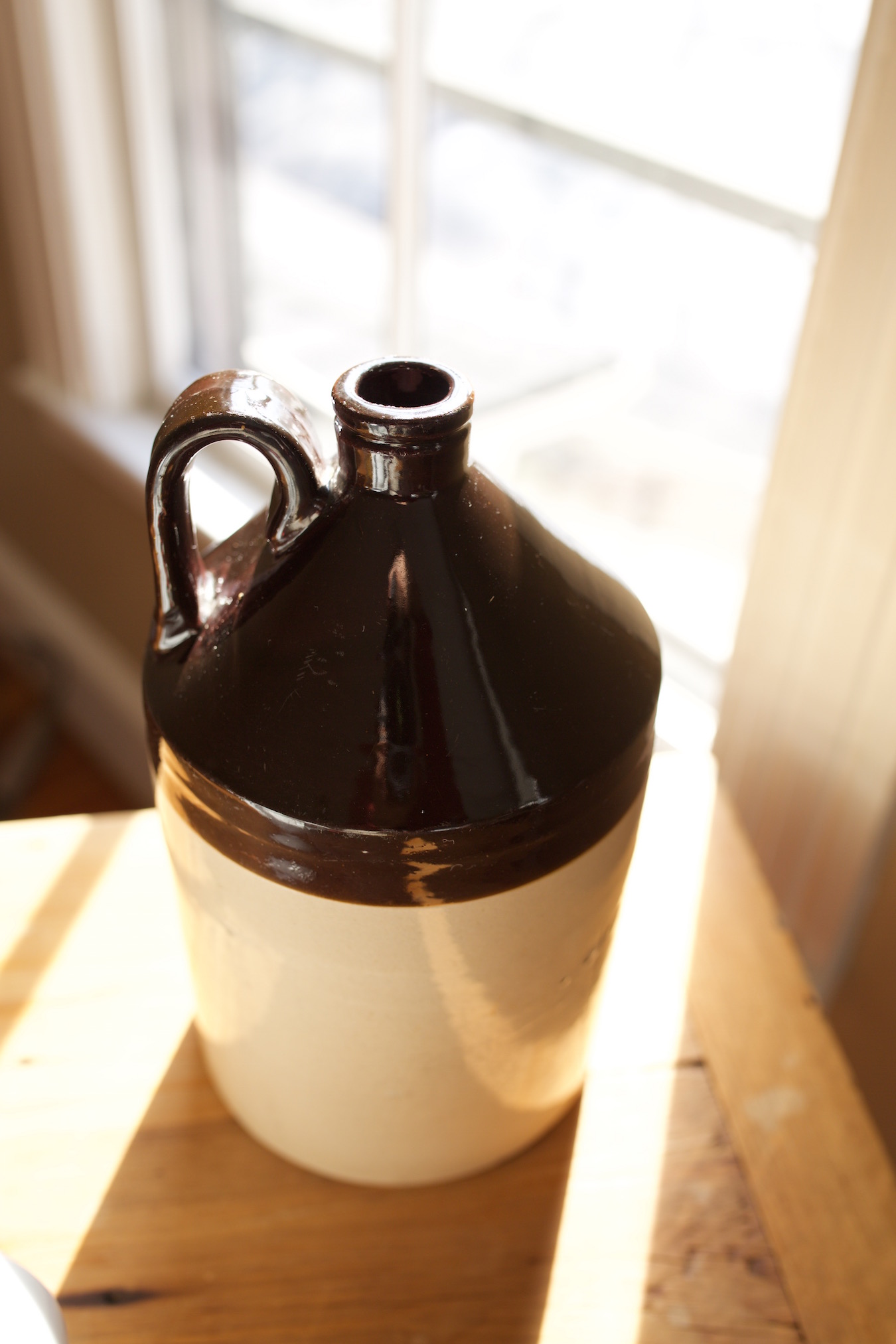
Why Make Your Own Herbal Homemade Wine?
Making your own herbal homemade wine and mead at home is actually a pretty simple affair. Emma Christensen provides an elegant equation that applies not only to these but pretty much all homebrews: “Sugary liquid + yeast (and the occasional friendly bacteria) + time = delicious fermented beverage” (Christensen, 2013, p. 1). Making your own wine is not illegal, and it won’t make your kitchen smell weird. Although you can add lots of bells and whistles to the process if you’d like, making wine doesn’t require any fancy equipment, either (we’ll talk about that in a bit).
An added benefit of crafting your own fermented beverages is the creativity it encourages. If you plan in advance, you can turn out special brews for holidays, for anniversaries or as a special gift for loved ones. You can create most anything you heart desires, based on your tastes and the availability of ingredients.
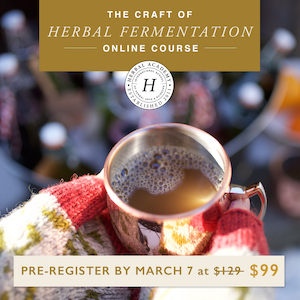
Join us in our newest Short Course here at the Herbal Academy – The Craft of Herbal Fermentation, and discover the excitement and liberation that comes from creating herbal fermentations with in-depth written discussions and video tutorials.
This new Short Course is now open for pre-registration! Sign-up during pre-registration and save on your enrollment. The Craft of Herbal Fermentation Course is regularly priced at $119 with an upgrade option of $149 to receive a set of durable laminated charts, but if you pre-register for the course you get it for only $99.
CLICK HERE to learn more about this exciting new course!
Getting Started
The first herbal wine I made was with dandelion flowers, based on my (105-year-old!) grandmother’s recipe, and it was amazing. When I couldn’t find dandelions later in the summer, I got creative and tried working with other flowers, herbs, and fruits. The blackberry-hibiscus wine was next then a gorgeous pear-and-lemon balm version. Last summer I experimented with a heavenly vanilla mead made with local honey and wild yeast. Yummy!
When it comes to making wine and mead, it can be helpful to have a good book or two as a guide or to take a course on fermenting, but experimentation is an important part of the process too. And just as with commercial wine, there’s a huge measure of variability in your results based on factors both within and outside of your control. If you follow a few basic but important steps, the worst that can happen is a not-too-tasty result (or possibly an exploding bottle, but don’t worry—we’ll talk about how to prevent that from happening).
Are you ready? Let’s get brewing!
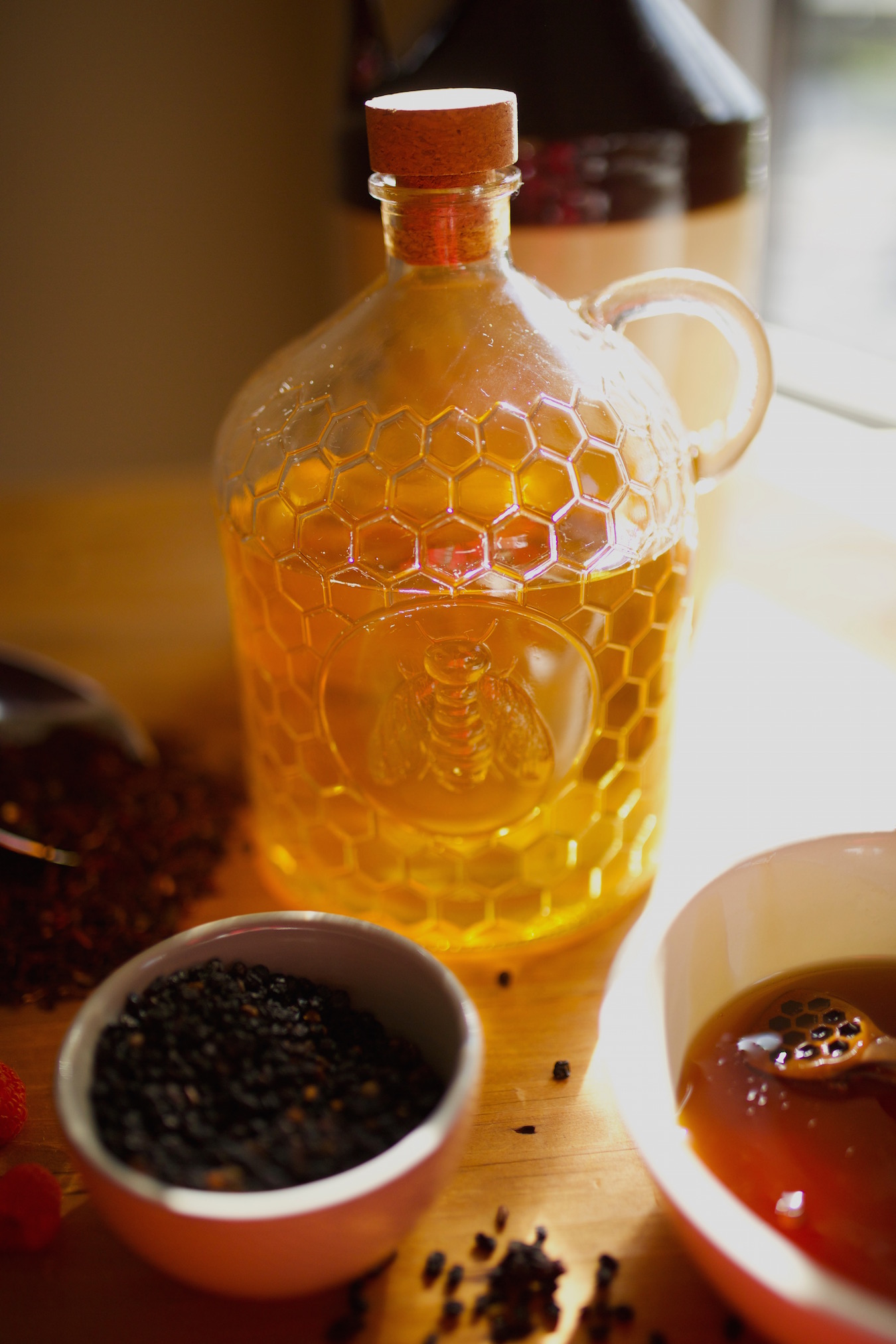
Herbal Homemade Wine and Mead
What Will I Need?
That all depends on what you’re making and on your personal taste. However, there are some basic ingredients you’ll want to have on hand for making wine and mead as well as a few not-so-basic optional ingredients.
Water: If you have good-quality tap water, you can use that; otherwise, use filtered or distilled water in making your wine and mead. Tap water will generally need to be dechlorinated if you don’t plan to boil it in the process of making your brew. To dechlorinate your water, you can boil and then allow it to cool, or leave it in an uncovered container for 12 hours so the chlorine can evaporate.
Sugar: Yeast needs food in order to produce alcohol, and several types of sugar can serve this purpose. Generally, organic granulated cane sugar will be your best option here because it ferments cleanly (that is, the yeast will consume all of it until the alcohol level of the fermentation kills them off). It also won’t add any additional flavor to your brews. Christensen (2013) recommends using brown sugar or turbinado for a caramel-like flavor, which might be better suited to mead.
Honey: Honey, preferably produced locally, is the essential ingredient in mead. It can be substituted in wine recipes for sugar, but will contribute its own flavor to the mix. If you use honey rather than sugar, you’ll need to add an additional ½ cup for every cup of sugar (for example, if the recipe calls for 2 cups of sugar, you’ll use 3 cups of honey).
Herbs: Herbs have traditionally been added to wine to add both flavor and health-supporting value. A mead made with herbs is technically called a “metheglin.” An especially well-loved brewing herb is meadowsweet, used from at least medieval times until the present day to flavor mead, wine, and beer; in 14th-century England, it was called “madwort” or “meadwort” (Grieve, 1971). Nicholas Culpeper (1990) and other physicians of his day added decoction of the leaves and flowers in wine to “make the heart merry” (although I wonder whether the ethanol content itself had a lot to do with this merriment!). Other herbs can also be used in making wine and mead as well such as lemon balm, hibiscus, ginger, hops, vanilla, rose, dandelion, even rosemary. Get creative!
Fruit: Use fresh, ripe, organic fruit in season whenever possible to get the best flavor and quality possible. Frozen fruit is second-best, and canned is a last resort (using fruit juice is also a possibility if it is 100 percent juice with no added sugars or preservatives).
Yeast: Any yeast fed by sugar content will lead to fermentation. Some strains, however, are better suited to specific types of brews. There are red wine yeasts, white wine yeasts, and champagne yeasts. Some strains are used to produce dry wine and others, sweet mead. I’ve had excellent results from wild yeasts too, starting my ferments in the garden and stirring with a wooden spoon exposed to the plants there. My grandmother used regular baking yeast!
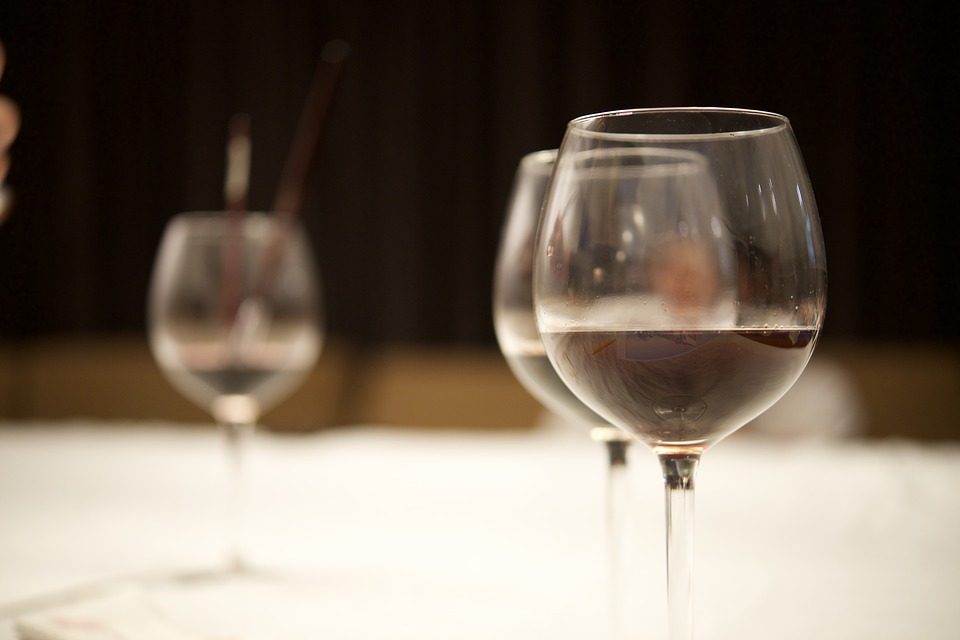
The following ingredients aren’t absolutely required for simple brewing, but can be helpful to have on hand. These aren’t available in grocery stores, but can be purchased at a brewing supply store or online:
Campden tablets: These are small tablets of a sulfite used to sterilize ingredients in wine and mead that the fermentation process can’t metabolize. It will kill bacteria and wild yeast, so it’s added to recipes before yeast, and a second tablet can be added to stabilize the fermentation before bottling (so that your bottles don’t explode if fermentation continues!). Some people are sensitive to sulfites and sulfates in wine; if this is you, omit this step.
Yeast nutrient: This is a powder that you can add to your fermentation to provide yeast the essential vitamins and minerals not naturally present in fruit, sugar, and honey.
Tannin: If you make wine with fruits or herbs that already are astringent (like blackberries or many lemon balm, for example), you won’t need to add tannin. However, adding a pinch of the powder to brews that aren’t already astringent will help balance the flavor.
Acid blend: This is another powder used to balance flavor (in this case, to add crispness to very sweet wine and mead).
You’ll also need some kitchen equipment and other items that can be purchased at a brewing supplier (or, in some cases, at a hardware store). To be completely honest, I tend to jerry-rig my own equipment or take shortcuts when making wine for myself (after all, it’s not Dom Pérignon!), but some of these items will make the process more convenient and less messy.
Equipment needed:
- Large stainless steel stockpot (2 or 3-gallon capacity)
- A digital scale
- Cheesecloth (or thin muslin cloth)
- Muslin drawstring bag
- Strainers: Large and small sizes, with fine stainless steel mesh
- Long-handled metal spoon
- Sanitizing solution (such as StarSan, or you can make your own by adding 1 tablespoon of bleach to 1 gallon of cold water)
- Thermometer
- Airlock
- Canning jars
- 2 gallon, food-grade bucket (it should have a rubber-lined hole to fit the airlock)
- 1-gallon glass jar with a lid that can accommodate the airlock (you might have to drill and add a rubber grommet to the lid, in this case)
- Funnel
- Racking cane and tip
- Siphon hose with a clamp
- Glass bottles
- Bottlecaps or wine corks
Let’s Brew!
Now that you have your ingredients and equipment gathered, it’s time to make wine (or mead)!
While your ingredients may vary from batch to batch depending on what you’re making and how long the fermentation process and aging takes, the process of making wine and mead follows the same basic steps.
These are:
- Prepare a sweet liquid
- Add yeast and stir frequently and well
- Allow to ferment
- Bottle
Here are a couple of recipes to spark your imagination and get you started:
Vanilla-Meadowsweet Mead
14 cups water
4 pounds honey
2 vanilla beans
2 ounces meadowsweet leaf and flower
2 Campden tablets
1 teaspoon acid blend
1 teaspoon yeast nutrient
A pinch of tannin
Yeast starter:
2 ¼ tablespoons honey
1 cup boiling water
1 packet dry champagne yeast
1/8 teaspoon yeast nutrient
- Sanitize a 2-gallon bucket, lid, airlock and spoon.
- In a stockpot, bring water to a boil and stir in honey until dissolved, then remove from heat. Add meadowsweet, let cool, then pour into the bucket.
- Split vanilla pods and scrape the seeds, adding them and the empty pods to the honey-water mix.
- Crush 1 Campden tablet and stir into the honey-water mix. Add the lid and attach the airlock, then let sit for a day.
- 12 hours after the Campden tablet is added, prepare the yeast starter by adding honey to boiling water in a canning jar, cooling to room temperature, then adding yeast and yeast nutrient. Cover the jar with plastic wrap, secured with a rubber band, then shake vigorously. Over the next half-day, the started will become frothy and yeasty-looking which is completely normal.
- After the honey-water-vanilla bean mix has been sitting for 24 hours, add yeast starter, tannin, and yeast nutrient. Stir vigorously and put the lid back on. Repeat this step with a sterilized spoon for the next week. (Within a day or so, you’ll know the brew has started to ferment because bubbles will appear in the airlock.)
- In a week, sanitize a gallon jar (and its lid and airlock), cheesecloth or muslin, funnel, and spoon. Remove vanilla pods with the spoon. Line the funnel with cheesecloth, then slowly pour the mead from the bucket into the jar; you’ll need to change the cheesecloth to remove the meadowsweet marc. Close the lid tightly.
- Let the mead sit in a cool, dark, dry area for at least 4 weeks (you can age it for up to 6 months or more if you’d like!). If you age the mead for longer than 4 weeks, you’ll want to occasionally siphon it off from lees, or the sediment that collects at the bottom of the jar. To do this, sanitize a stockpot, racking cane and tip, and hose and siphon the mead from the jar to the pot. Then repeat the funneling step above, transferring the mead back into the jar from the pot.
- When you’re ready to bottle the mead, crush a Campden tablet into the jar, stir, and let sit for at least 24 hours, then siphon the mead into sanitized bottles and cap (or cork) and label them. Don’t forget to include the date!
Blackberry-Hibiscus Wine
14 cups water
2 pounds granulated sugar
3 pounds blackberries
4 ounces dried hibiscus
2 Campden tablets
1 packet dry wine yeast
1 teaspoon yeast nutrient
A pinch of tannin
- Sanitize a 2-gallon bucket, lid, airlock and spoon.
- In a stockpot, bring water to a boil and stir in sugar until it dissolves, then add hibiscus and remove from heat. Let cool, then pour through a sterilized strainer into a bucket.
- Place blackberries in a mesh bag in the bucket. With clean hands, mash the bag so that the blackberry juice is extracted into the liquid.
- Crush 1 Campden tablet and stir into the liquid. Add the lid and attach the airlock, then let sit for a day.
- Prepare the yeast starter by scooping out one cup of the liquid with a sterilized measuring cup into a canning jar. Add the yeast and cover the jar with plastic wrap secured with a rubber band. Shake well and let stand for about three hours.
- Add yeast starter, tannin, and yeast nutrient and stir vigorously, then replace the lid and airlock. Repeat the stirring for seven days using a sterilized spoon.
- From this point, follow the same process as for the vanilla-meadowsweet mead, above.
As you can see, making your own herbal homemade wine and mead isn’t a complicated process, and success lies in paying attention to the details (like using fruit at peak ripeness, sourcing excellent quality aromatic herbs, being sure to keep vessels and utensils sanitized, and paying attention to timing).
Now is the perfect time to begin planning your summer herbal homemade wine and mead-making process because in most temperate climates the sweet fruits used for brewing (strawberries, blueberries, wineberries, peaches, pears, plums and more) will soon be in season. You’ll have to wait a bit to savor the results of your work, but it will be well worth it!
Learn more about making your own herbal mead as well as kombucha, water kefir, and lacto-fermented foods in our new Herbal Fermentation short course. Whether you are interested in creating delicious beer and mead to share with friends and family or are looking for ways to expand your probiotic routine through kombucha, water kefir, or fermented foods, The Craft of Herbal Fermentation Course will walk you through step by step, from start to bubbly finish.
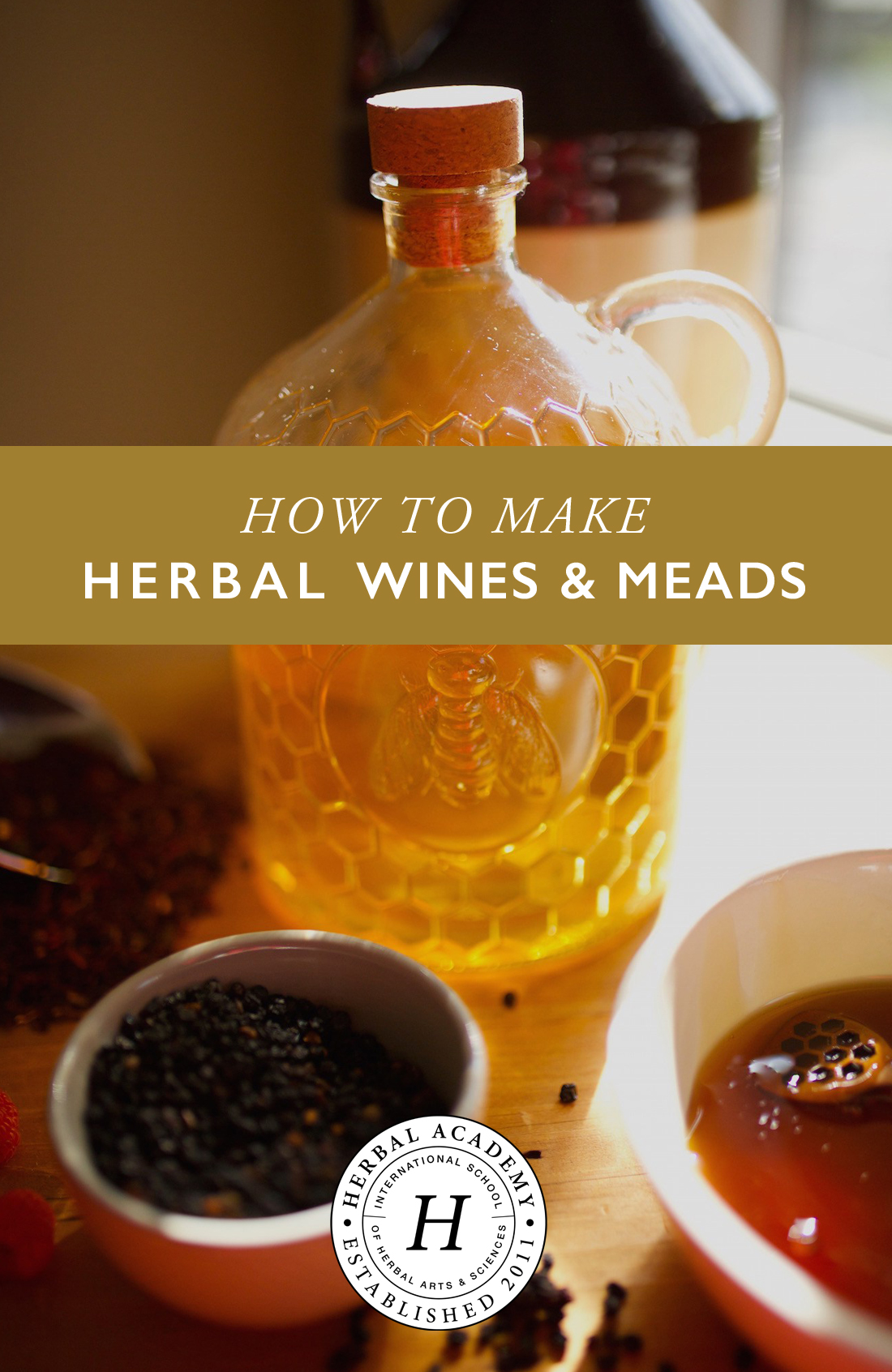
REFERENCES
Christensen, E. (2013). True brews: how to craft fermented cider, beer, wine, sake, soda, mead, kefir and kombucha at home. Berkeley, CA: Ten Speed Press.
Culpeper, N. (1990). “A Key to Galen’s Method of Physick” in Culpeper’s complete herbal, & English physician. Glenwood, IL: Meyerbooks.
Fichtl, R. and Adi, A. (1994). Honeybee flora of Ethiopia. Weikersheim, Germany: Margraf Verlag
Grieve, M. (1971). The modern herbal, vol 2. New York, NY: Dover Publications.
Johnson, H. (1999). Hugh Johnson’s story of wine. London: Mitchell Beazley.
Nash, D. W. (1858). Taliesin; or, the bards and druids of Britain. London: John Russell Smith.

